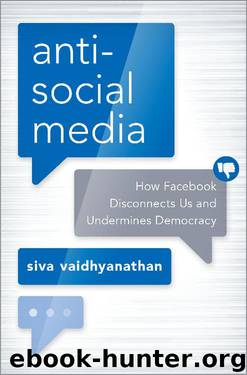Anti-social Media: How Facebook Disconnects Us and Undermines Democracy by Siva Vaidhyanathan

Author:Siva Vaidhyanathan [Vaidhyanathan, Siva]
Language: eng
Format: epub
Published: 0101-01-01T00:00:00+00:00
6
The Politics Machine
The first surprise arrived on June 23, 2016. Conservative prime minister David Cameron had pandered to his party’s hard-line, anti-Europe wing by allowing a United Kingdom–wide popular referendum on whether his country should sever ties with the European Union, of which the United Kingdom was a founding and leading member. Cameron was confident that his party’s rank and file, and thus a majority of the nation as a whole, would act conservatively. After all, it was the Conservative Party.
He assumed that the sober business community would make the case that the financial, trade, and labor disruptions of leaving the European Union would be devastating. He assumed that those to the left of the Conservative Party would rally their supporters to defend the free flow of labor to the United Kingdom and the reciprocal opportunities for those from the United Kingdom to find work on the Continent. Still, there were loud, hard-line provocateurs within the Conservative Party, and a growing party to the right called the UK Independence Party, or UKIP. Cameron decided that the only way to move on from the constant complaints those factions put forth about the erosion of traditional English culture and the weaknesses in labor markets in the face of steady migration from poorer Eastern and Southern Europe was to once and for all demonstrate that the voters of the United Kingdom do not fear their neighbors and see openness as working to their advantage.
Cameron was wrong. More than thirty million people voted in the referendum, with 51.9 percent voting to leave the European Union and 48.1 percent voting to stay. The two sides had become known by their simple verbs: Leave versus Stay. The victory of the Leave campaign not only shocked conventional wisdom, it surprised many of those who had been issuing and following polls for months. The polls had been very noisy and inconsistent for weeks before the election. But conventional wisdom settled on the prediction that Stay would win narrowly. The British betting markets, which often accurately predict elections, had settled on an 88 p ercent chance that a majority of the voters would opt to stay. But the very inconsistency and narrowness of the polls demonstrated that they had fairly closely predicted the result—or at least its strong possibility.[1]
The Conservative Party, and thus the government of the United Kingdom, was thrown into turmoil. Cameron resigned immediately. After much shuffling, strutting, bluffing, and palace intrigue among various leading figures in the party, Theresa May emerged victorious and assumed the job of prime minister. May had opposed the vote to Leave, but after it passed she endorsed a vague plan to execute the will of the voters and leave the European Union. Business and finance leaders of the country began planning for the turmoil and the loss of markets for goods and labor. Major firms, including those in banking, began to look for new homes in cities such as Frankfurt now that London seemed unfriendly.
Pundits and journalists quickly searched for explanations. Even if the polls had not botched the prediction, the very fact that so many U.
Download
This site does not store any files on its server. We only index and link to content provided by other sites. Please contact the content providers to delete copyright contents if any and email us, we'll remove relevant links or contents immediately.
Deep Learning with Python by François Chollet(12957)
A Developer's Guide to Building Resilient Cloud Applications with Azure by Hamida Rebai Trabelsi(10381)
Hello! Python by Anthony Briggs(10198)
The Mikado Method by Ola Ellnestam Daniel Brolund(10107)
OCA Java SE 8 Programmer I Certification Guide by Mala Gupta(10043)
Dependency Injection in .NET by Mark Seemann(9581)
Hit Refresh by Satya Nadella(9016)
Algorithms of the Intelligent Web by Haralambos Marmanis;Dmitry Babenko(8588)
The Kubernetes Operator Framework Book by Michael Dame(8377)
Exploring Deepfakes by Bryan Lyon and Matt Tora(8179)
Robo-Advisor with Python by Aki Ranin(8131)
Practical Computer Architecture with Python and ARM by Alan Clements(8114)
Implementing Enterprise Observability for Success by Manisha Agrawal and Karun Krishnannair(8095)
Svelte with Test-Driven Development by Daniel Irvine(7986)
Building Low Latency Applications with C++ by Sourav Ghosh(7984)
Sass and Compass in Action by Wynn Netherland Nathan Weizenbaum Chris Eppstein Brandon Mathis(7969)
Grails in Action by Glen Smith Peter Ledbrook(7942)
Becoming a Dynamics 365 Finance and Supply Chain Solution Architect by Brent Dawson(7904)
Test-Driven iOS Development with Swift 4 by Dominik Hauser(7900)
